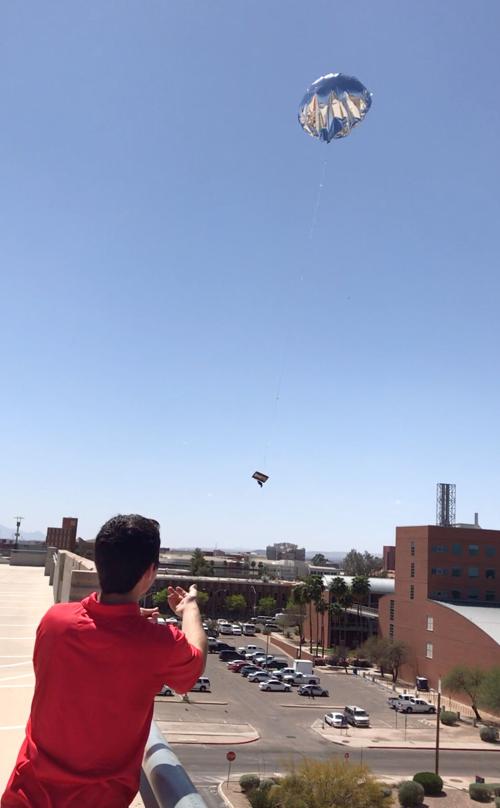Move over, Jules Verne. An engineering team from the University of Arizona just sent three balloons on a flight around the world, and the trip took a lot less than 80 days.
The small helium-filled balloons were launched April 2 from the roof of the UA’s Highland Parking Garage, and they arrived back in Arizona on April 15 after riding the jet stream around the globe.
They crossed back over the state near Phoenix and kept going, carried along by high-altitude winds at about 40,000 feet and more than 100 mph.
“It was really exciting,” said team member Josh Crest, a UA senior majoring in mechanical engineering. “One of our goals is to try to stay up as long as possible and collect as much data as possible.”
Jekan Thanga is a professor of aerospace and mechanical engineering in the UA College of Engineering. He said the techniques and technologies the team is testing could one day provide a low-cost alternative to space-based satellites. Such balloons also could be used to gather real-time data about the jet stream from inside of it.
Then there are the off-world applications.
Thanga pictures science-gathering swarms of the balloons circling Venus in what he called that planet’s “Goldilocks zone,” where the atmospheric pressure is similar to Earth’s.
“The conditions there are not so bad,” he said. “The one little inconvenience is the sulfuric acid clouds.”
Obviously, mylar or some other thin plastic won’t work in a place like that, so the balloons would have to be made from something like glass or Kevlar, Thanga said.
It’s not as science-fictiony as it sounds. In 1985, the Soviet Union successfully deployed a pair of balloons coated in a kind of Teflon that survived in the hot Venusian atmosphere for about 46 hours.
The idea of using balloons to study Venus and search for traces of life is what attracted Crest to the project.
University of Arizona engineering students Josh Crest (in red) and Michael Debbins release two different balloon prototypes from the roof of the Highland Parking Garage on April 2. Three of their balloons circled the globe and flew back across Arizona 13 days after being launched. Courtesy of Claire Bukowski, Josh Crest and Michael Debbins
He said he has been interested in space exploration since he was a kid. Now he is a NASA Space Grant recipient who dreams of landing a job at Johnson Space Center in Houston after he graduates.
Crest said he and fellow senior Michael Debbins assembled the balloons themselves, using mostly “commercial, off-the-shelf products to keep the cost down.”
Each balloon carries a small circuit board and a long wire antenna to collect and transmit basic flight and weather data. The on-board “computer” is powered by a paper-thin solar panel no bigger than a playing card.
The whole package weighs about half as much as a golf ball.
There are no onboard batteries to fail in the frigid air high above the ground, so the balloon only transmits when there is enough sun hitting its solar panel. The rest of the time, “it just goes to sleep,” Thanga said.
The balloons are small and light enough that the Federal Aviation Administration doesn’t bother to regulate them. “They sort of put them in the ‘ignore’ category,” Thanga said.
Crest and Debbins built four prototypes in all — two that were carried aloft with shiny, store-bought mylar party balloons, and two that used what looked like thin, clear plastic, dry cleaner bags.
The clear ones only look cheap, Crest said. They’re actually science-grade “lift bags” that cost about $160 each.
One of the four balloons never made it to the jet stream, Thanga said. It’s stuck in a tree somewhere along the Arizona-New Mexico border, where it continues to transmit.
The remaining three traveled more than 18,600 miles in 13 days without requiring a drop of fuel. Their flights were tracked using a global, crowd-sourced network of amateur radio operators, many of whom have equipment that automatically receives and relays transmissions like the ones sent out by the balloons.
Something like 10,000 “pings” from the balloons were picked up and reported by ham operators around the world, including some who picked up the signal from almost 5,000 miles away, Thanga said.
That’s how the team knows what ultimately happened to the balloons.
University of Arizona engineering students Josh Crest (in red) and Michael Debbins release two different balloon prototypes from the roof of the Highland Parking Garage on April 2. Three of their balloons circled the globe and flew back across Arizona 13 days after being launched. Courtesy of Claire Bukowski, Josh Crest and Michael Debbins
A day or so after they crossed back over Arizona, all three flew into a storm over the Deep South. Since then, Crest said, their signals have been stuck in Mississippi, suggesting they aren’t flying anymore.
Still, this was progress. The team’s previous attempt in February involved a single balloon that made it past Japan before being swept up in a storm, never to be heard from again.
Future prototypes could be equipped with an onboard system to make more “lifting gas” and a more robust power source to improve communication, Thanga said.
If they can design something that will reliably stay aloft for a year, he said, “then it becomes a viable, satellite-like platform.”
Crest said this was probably his last launch before he graduates, so it will be up to the next class of engineering students to build that better balloon.
“I think it’s definitely doable,” he said.





